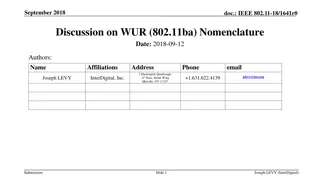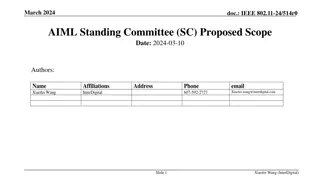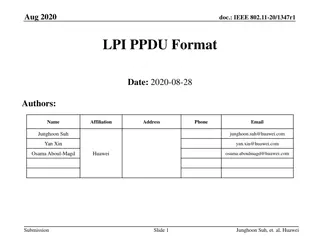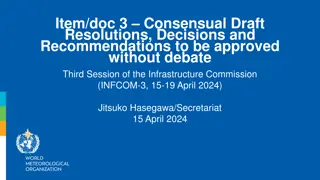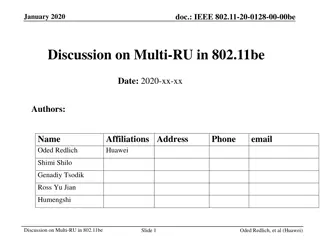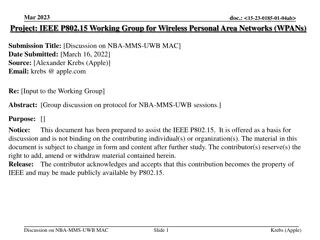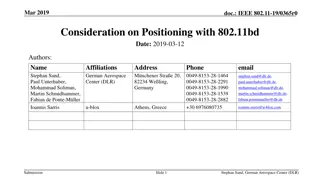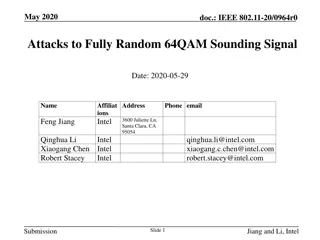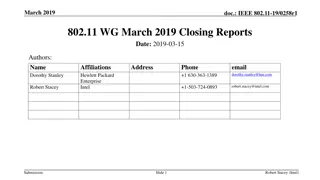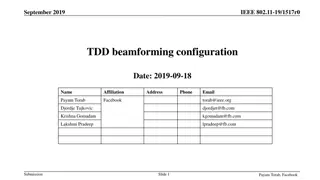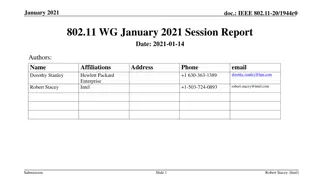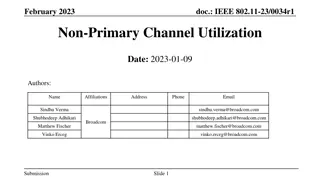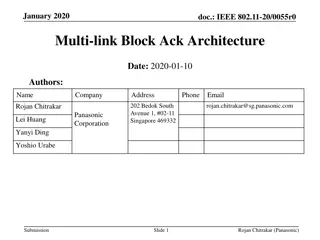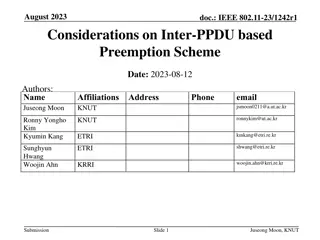Discussion on CID 35 and Proposed Resolutions in IEEE 802.11-23/0623r2
Presentation by Mark Hamilton from Ruckus/CommScope discussing consensus on CID 35 in TGbh CC41, including proposed updates, comments, and resolutions regarding opaque identifiers, Device IDs, and network procedures. Various discussions held on identifier constructions and terminology.
Download Presentation

Please find below an Image/Link to download the presentation.
The content on the website is provided AS IS for your information and personal use only. It may not be sold, licensed, or shared on other websites without obtaining consent from the author. Download presentation by click this link. If you encounter any issues during the download, it is possible that the publisher has removed the file from their server.
E N D
Presentation Transcript
May 2023 doc.: IEEE 802.11-23/0623r2 Discussion on CID 35 Date: 2023-05-02 Authors: Name Mark Hamilton Affiliations Ruckus/CommScope Address 350 W Java Dr. Sunnyvale, CA 94089 Phone +1-303-818-8472 email mark.hamilton2152@gmail.com Submission Slide 1 Mark Hamilton, Ruckus/CommScope
May 2023 doc.: IEEE 802.11-23/0623r2 Abstract Presentation for discussion, to reach consensus on TGbh CC41 CID 35 r0 initial version r1 updates during April 11 teleconference discussion (not concluded) r2 proposed updated wording, and consensus agreed on May 2 telecon Submission Slide 2 Mark Hamilton, Ruckus/CommScope
May 2023 doc.: IEEE 802.11-23/0623r2 CC41 CID 35 CID Commenter Comment Page Subclaus e Line Proposed Change I guess I'm in general a bit confused as to whether "the identifier" is always an "opaque identifier" as in Annex Z, or whether there are different identifiers defined in subclause 12.2.11. Adding a sentence on identifiers would help, perhaps along the lines of "An opaque identifier can be constructed by the network according to the example procedure in Annex Z, but an identifier can also be differently constructed by a mechanism chosen by the network." I guess the non- AP STA would not technically need to be concerned with how the identifier is constructed. Amelia Andersdotter As in comment. It's very general. 35 2612.2.11 6 Submission Slide 3 Mark Hamilton, Ruckus/CommScope
May 2023 doc.: IEEE 802.11-23/0623r2 Discussion on April 4 On April 4, presented this proposed resolution: Insert a new paragraph at the end of 12.2.11, "An opaque identifier can optionally be constructed by the network using the procedure in Annex Z or can employ a different mechanism provided it affords comparable security and privacy. Discussion/concerns from that call: We don t have the term opaque identifier in our text anymore (at least not in the main/normative parts). Referencing that term in this sentence will be confusing. We don t use identifier anymore, either, after the recent (tentatively agreed) proposed text updates. Suggest Device ID . (Is that upper case, or lower case?) Does this force us to define terms for the identifier concept (internally at/above the AP), versus what is sent over the air? Can we word it to not force us to update everything with different terms? Submission Slide 4 Mark Hamilton, Ruckus/CommScope
May 2023 doc.: IEEE 802.11-23/0623r2 Proposed resolution Some assumptions/clarifications attempted in this text: Clarify that Annex Z is constructing the structure to be sent over the air. This has no impact on the identifier concept itself Clarify that this procedure is only used with the Device ID method (not the IRM method), and is therefore only done at the AP ( network ) side. Proposal: Insert a new paragraph at the end of 12.2.11.1: For purposes of creating a Device ID that can be sent over the air without exposing the underlying device identification, the procedure in Annex Z, or any procedure (including nothing, if appropriate), can optionally be used by the AP to keep the Device ID content private ( opaque ) from third- parties. (Consensus reached on the above, on May 2 teleconference.) Submission Slide 5 Mark Hamilton, Ruckus/CommScope













